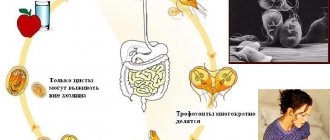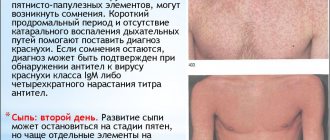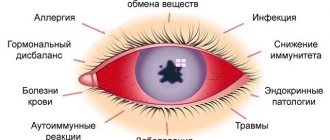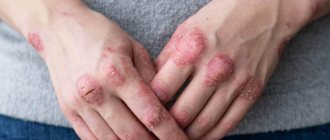Published: 10/26/2021 15:20:00 Updated: 10/26/2021
Giardiasis is a protozoal infection caused by the protozoan Giardia, which affects the small intestine. Manifested by indigestion. This infectious agent was first described by the Czech doctor D. F. Lambal in 1859. Not only the parasite, but also the disease was later named after him.
According to WHO, about 200 million people worldwide are infected with Giardia every year. Most often this happens in the countries of Asia, Africa, and Latin America. According to official data, up to 150 thousand infections with these protozoa are detected in Russia every year.
Giardiasis is often the cause of intestinal disorders in children of preschool and primary school age. In adults it is mostly asymptomatic.
Causes
Giardia is the simplest microscopic unicellular parasite from the class of flagellates.
In the human intestine it can be in two forms - vegetative and spore. Giardia reproduces by division and doubles in number every 10-12 hours. The habitat of vegetative forms is the upper section of the small intestine. Cysts are immobile, oval in shape and protected by a capsule. In this form, Giardia exists in the colon, as well as in the external environment. This way they can remain viable for a long time. The main causes of giardiasis are the entry of cysts into the human body. This happens when eating unwashed vegetables and fruits, violating hygiene rules, and using unboiled water. This route of transmission is called fecal-oral, since the source of the spread of giardiasis pathogens is an infected person who excretes cysts along with feces. Pets can also be carriers of giardiasis, and flies and cockroaches act as carriers.
Provoking factors can be overcrowding, living in a polluted environment, poor condition of water supply and sewerage systems, and non-compliance with sanitary and hygienic rules. A predisposition to the disease has been identified in children under the age of 10 years, in people with malnutrition or dystrophy, congenital defects of the biliary tract, diseases of the stomach and intestines with a reduced level of acidity, as well as in those adhering to diets with too low a protein content.
What happens after infection?
To become infected, it is enough to swallow several dozen cysts (the patient secretes millions of them per day, so you can imagine the likelihood of infecting others if he does not follow the rules of personal hygiene). After entering the small intestine, each cyst is divided into two halves, from which two lamblia are formed, which also begin to actively multiply.
Further development of parasitic infestation can follow two scenarios:
- Symptoms of the disease will appear.
- The person will become an asymptomatic carrier.
The likelihood of developing clinical giardiasis is influenced by a number of factors:
- state of human immunity;
- acidity of gastric juice (low acidity contributes to high activity of Giardia and the manifestation of giardiasis);
- the presence of problems with the secretion of bile (if there is not enough of it in the small intestine, it will be easier for Giardia to take root in the body).
In case of carriage, cleansing of the intestines from the parasite can occur spontaneously, without any treatment. The only condition is that self-infection should not occur, that is, the person must carefully observe the rules of personal hygiene.
If Giardia takes root and begins to multiply, the first thing that happens in the intestines is a violation of parietal digestion, as a result of which various intestinal disorders and signs of a lack of certain substances in the body arise. In addition, Giardia can influence intestinal motility by irritating nerve endings. This causes painful cramps in the abdomen.
In people prone to allergies, the products secreted by parasites in the process of vital activity sensitize the body, so patients develop various allergic reactions. These same products also poison a person, causing symptoms of intoxication.
Classification
Signs of giardiasis may not be noticeable in a quarter of all cases.
This condition is called asymptomatic carriage. In this case, the person himself is not sick, but he becomes a source of infection for others. In half of all patients with giardiasis, the disease is subclinical. They also have no symptoms and do not consider themselves infected. Only diagnostics can help identify the disease.
And only in the remaining percentage of patients the disease has pronounced symptoms, which can be acute, subacute or chronic.
Clinical symptoms of giardiasis and disease outcomes
Clinical symptoms of giardiasis are multiform. According to the WHO classification there are:
- giardiasis asymptomatic,
- clinically pronounced giardiasis: intestinal form (duodenitis and duodenal dyskinesia, enteritis and enterocolitis), hepatobiliary form (cholecystitis and biliary dyskinesia), extraintestinal manifestations of giardiasis: neurasthenic syndrome, allergies and skin lesions.
Manifest (clinically expressed) forms of the disease occur with massive infestation, a high degree of parasite virulence and low immunity of the infested person. The frequency of registration of cases of manifest disease ranges from 14 to 43%.
Chronic forms of the disease are more often observed in preschool children. Periods of exacerbations are followed by remissions. The disease drags on for months and years. Digestive disorders and developed vitamin deficiency lead to weight loss in patients and the development of extraintestinal forms of the disease.
The wave-like course of giardiasis is observed with autoinvasion (self-infection). The asymptomatic course of giardiasis is recorded in half of the cases of the disease in the form of carriage or subclinical forms.
Outcomes of giardiasis
- With adequate treatment, the duration of the disease is about 7 days.
- There are cases of spontaneous healing, which occurs after 1 to 4 weeks.
- Insufficiency of IgA immunoglobulins leads to a chronic process that lasts months and years. Body weight gradually decreases. Neurological symptoms and vegetative-vascular manifestations appear, allergies develop, and the skin is affected. The release of cysts in such patients occurs cyclically with an interval of 10 - 20 days.
- Carriage of Giardia is often combined with Shigella, which aggravates the course of dysentery. In this case, the disease becomes chronic and immunogenesis is disrupted. Giardiasis aggravates the course of viral hepatitis and typhus and contributes to the chronicity of these diseases.
Rice. 12. Vegetative forms of Lamblia intestinalis penetrate the intestinal mucosa (microscopy of a section of the intestinal wall).
Symptoms
Giardiasis often has mild symptoms and occurs without pronounced clinical manifestations.
In the typical form of the disease, the first symptoms begin to appear after the end of the incubation period, which lasts from 1 to 3 weeks, and during this time the disease has no manifestations. The intestinal form of the acute stage is characterized by:
- Pain in the right hypochondrium, in the navel area and rarely in the lower abdomen.
- Belching.
- Feeling of heaviness in the left side of the abdomen.
- Decreased appetite.
- Frequent bowel movements up to 3-5 times a day, which can give way to constipation.
- Nausea.
- Constant feeling of heaviness in the stomach.
- Flatulence.
In young children, mushy stools are observed.
The duration of the acute phase of the disease is 5-7 days, after which either recovery occurs or the infection transitions to a subacute chronic course. The hepatobiliary variant of giardiasis in women and men is manifested by pain in the liver area and indigestion.
Skin manifestations can be very different and include pallor, the appearance of a icteric tint, dryness and flaking, and a small allergic rash. Stomatitis may develop in the mouth, and jams or cracks may appear in the corners of the mouth.
The intoxication syndrome during giardiasis depends on how many cysts enter the body, as well as on the duration and severity of the disease. Patients may complain of headaches, dizziness, sleep disturbances, decreased performance, irritability, and emotional lability. Children may experience tics, hyperkinesis, and fainting.
Additional drug therapy
To influence pathogenic intestinal microflora, Enterol (1-2 capsules or a packet of powder 2 times a day for a week) or Intetrix (4 capsules per day for four days) is usually prescribed. To combat dysbiosis, probiotics are used (Narine, Linex, Bio-Gaia, Bifiform, etc.). For liver damage, hepatoprotectors (Gepabene, Karsil) and choleretic agents (Allohol) are indicated. Also, to improve the functioning of the gallbladder, you can use drugs such as Hofitol or Holosas. By the way, these drugs slightly increase urination, which promotes the rapid elimination of toxins.
If the results of the coprogram indicate an enzymatic deficiency, then Mezim, Festal, Creon or Pancreatin are prescribed. Even in the absence of clinical symptoms of an allergic reaction, antihistamines are necessary. These are Erius, Claritin, Telfast, Cetrin. 1 – 2 tablets per day is enough. Sometimes you may feel drowsy after using these medications. That is why it is recommended to take them in the afternoon before bed.
Acute and chronic giardiasis most often occurs in people with weakened immune systems. Therefore, after the end of antiparasitic therapy, it is necessary to identify the cause of disturbances in the functioning of the immune system. In some cases, additional drug support with immunomodulators (Polyoxidonium, Lykopid) is necessary.
Diagnostics
Testing for giardiasis is the only reliable way to identify the disease, since it often occurs without symptoms and has no specific manifestations.
The main list of tests for diagnosing giardiasis includes:
- Antigenic test for Giardia, to detect them in feces using ICA (immunochromatographic). Helps identify acute or chronic forms of giardiasis, asymptomatic carriers, and is also an effective method for evaluating treatment.
- Determination of antibodies of classes A, M, G (IgM, IgA, IgG) to Giardia in the blood using ELISA (enzyme-linked immunosorbent assay) for timely detection of infection.
- Express examination of stool for antigens to Giardia, amoebae, and cryptosporidium, which helps to diagnose parasitic diseases that occur without obvious symptoms.
- Microscopic method for examining stool for protozoa and helminth eggs.
- Fecal analysis for carbohydrates, which is prescribed for diseases of the small intestine with suspected Giardia infection.
All other tests and studies for giardiasis are considered nonspecific and are prescribed according to indications. These may be blood tests, urine tests, gastroscopy or ultrasound of the abdominal organs.
Folk recipes
We bring to your attention several common recipes for traditional treatment of giardiasis that help remove giardia from the body:
- prepare a decoction of burnet (6 grams of herb per glass of water, boil for 10 minutes), which is taken once a day before meals. Dosage – 100 ml;
- 100 ml of beet juice are mixed in equal proportions with carrot juice, cognac and honey. The mixture is thoroughly mixed and taken three times a day half an hour before meals;
- Take green walnuts, cut them into several pieces and pour in 1 liter of vodka. The tincture reaches its condition in a dry, dark place within two weeks. The medicine is taken three times a day, one teaspoon.
Treatment
Giardiasis requires complex treatment.
Therapy for uncomplicated forms is carried out on an outpatient basis. When the diagnosis is confirmed, one of the antigiardiasis drugs is prescribed, which must be combined with the use of choleretic drugs, as well as drugs that improve intestinal microflora. The chronic course requires long-term complex treatment, which will include not only medication, but also a diet for giardiasis, which limits the intake of carbohydrates into the body. Etiotropic drugs help to cope with protozoa, and immunotherapy helps to increase a person’s natural defenses. Choleretic agents and probiotics must be prescribed to restore intestinal microflora.
Modern medicine in the treatment of giardiasis offers some clinical recommendations. At the first stage, diet therapy and fasting days are prescribed, as well as taking choleretic and, if necessary, antihistamines.
At the second stage, the patient takes special antiprotozoal drugs prescribed by the doctor. To get rid of Giardia, not one, but two courses are often prescribed.
At the third stage, multivitamins, enterosorbents, enzyme preparations, immunostimulants, and herbal medicine are used.
How to treat giardiasis?
For acute forms of giardiasis in adults, a one-stage treatment regimen with a course of antiparasitic therapy can be used.
- The drug of choice is metronidazole for a course of treatment of 5-7 days. Adults are prescribed 250 mg, children - 15 mg/kg/day. in 3 doses every 8 hours (without chewing, during or after meals, or washed down with milk).
- Another dosage regimen for adults: 2.0 g in one dose for 3 days or 0.5 g / day. within 10 days. According to a clinical and pharmacological article, specific dosages are recommended for the treatment of giardiasis: for adults - 500 mg 2 times a day for 5-7 days, for children 3-5 years old - 250 mg / day, 5-8 years old - 375 mg / day, over 8 years - 500 mg / day. in 2 doses, course of treatment is 5 days.
- It should be borne in mind that at the moment the use of metronidazole and other nitroimidazole derivatives, as well as furazolidone, is losing its relevance due to the emergence of a large number of parasite strains resistant to them.
It is not advisable to begin treatment of chronic giardiasis with the use of antiparasitic drugs, as this can lead to toxic-allergic complications and exacerbation of the clinical symptoms of the disease. Therefore, treatment in such cases should be carried out in three stages:
- The first stage is the elimination of toxicosis, improvement of intestinal enzymatic activity, correction of the immunological status. Depending on the severity of the symptoms of the disease, stage 1 is carried out over 1-2 weeks and includes: a diet that is aimed at creating conditions that worsen the reproduction of Giardia (porridge, dried fruits, vegetables, vegetable oil); limiting carbohydrate intake; taking choleretic drugs; administration of enterosorbents; enzyme therapy (based on the results of the coprogram); antihistamines.
- The second stage is antiparasitic therapy with drugs that affect protozoa: trichopolum (metronidazole), furazolidone, tiberal (ornidazole). Taking antihistamines and enterosorbents continues throughout the entire antigiardiasis therapy.
- The third stage is increasing the body's defenses and creating conditions that prevent the proliferation of Giardia in the intestines and gall bladder. For this, a diet is prescribed that improves intestinal motility (cereal porridges, vegetable and fruit purees, baked apples, fresh fruits and vegetables, dairy products). To correct the immune response, herbal adaptogens and multivitamin complexes are prescribed. To eliminate intestinal dysbiosis and fermentopathy, probiotics, prebiotics, and enzyme preparations are prescribed. The third stage takes on average 2-3 weeks.
To reduce the toxic effect of Giardia decomposition products under the influence of etiotropic treatment in children over 5 years of age, it is recommended to use Demyanov tubes with mineral water, 25-30% solution of magnesium sulfate, sorbitol, and xylitol 1-2 times a week. This measure prevents the absorption of toxic products and weakens the manifestations of the Yarisch-Herxheimer reaction. Along with specific treatment, the patient is prescribed plenty of fluids and diet. If the syndrome of maldigestion and malabsorption is detected, enzyme therapy is prescribed; if intestinal dysbiosis is detected, appropriate correction is carried out.
Prevention
After recovery, the risk of re-infection does not decrease, and relapses occur frequently.
To completely get rid of parasites, repeated doses of medication are often required. Dispensary observation is carried out for 3-6 months with mandatory examination for parasites. To prevent infection with giardiasis, you should not drink raw water, even from the tap, follow all sanitary and hygienic rules, be sure to wash your hands before eating and after using the toilet, and do not eat unwashed vegetables, fruits, and berries.
It is important to consult a doctor at the first suspicion of a disease and undergo all the necessary tests to refute or confirm the diagnosis with further mandatory treatment.
Author:
Pugonina Tatyana Alekseevna, Therapist
Nutrition rules
The diet for giardiasis in adults at the first, preparatory stage, is based on products that slow down the reproduction of giardia. It is recommended to limit the consumption of carbohydrates (flour dishes and sweets) to a minimum and give preference to protein foods and foods high in fiber. During this period, the patient needs to consume:
- Dried fruits;
- Fresh and boiled vegetables;
- Lean meat;
- Various cereals;
- Vegetable oil.
At the third, recovery stage, the daily menu is based on products that improve intestinal motility. The diet includes:
- Fermented milk products (kefir, yogurt, cottage cheese);
- Boiled lean meat and lean fish;
- Porridge (oatmeal, buckwheat, pearl barley);
- Fruit and vegetable purees;
- Fresh fruits and vegetables (cabbage, carrots, apples, pears);
- Berries (cranberries, lingonberries);
- Baked apples;
- Greenery.
Bread, flour, confectionery and sweets, whole milk, and pasta should be completely excluded from the diet. It is recommended to avoid sausages, canned meats and animal fats. From cereals you can eat rice, buckwheat, pearl barley.
The patient must adhere to an increased drinking regime in order to quickly cleanse the body of toxins. It is useful to drink sour fruit drinks from cranberries, lingonberries, green tea with lemon, fresh juices (carrot, beetroot, birch).
Giardia in children
“Perhaps the child has parasites?!” Parents may ask this question if their child suffers from allergies, indigestion, or poor appetite.
One of the common parasitic diseases in children is giardiasis.
How does infection with the causative agent of giardiasis, Giardia, occur? What tests should a child undergo for Giardia? How to get rid of these parasites?
These and other questions are answered by Elena Gennadievna Koroleva, a children's infectious disease specialist at Clinic Expert Tula.
— Elena Gennadievna, many parents have probably come across the term “giardia.” What is it and what does Giardia look like?
- These are small protozoan parasites invisible to the naked eye. They are the causative agents of giardiasis. They are an amoeba with a flagellum. Giardia lives in the small intestine of humans and other mammals, as well as birds. They are excreted with feces in the form of cysts.
— Where does Giardia come from in a child’s body?
— There are several ways that Giardia cysts can enter the body:
- Contact – when using common hygiene products, utensils
- Water – when swimming in polluted waters or drinking raw water from questionable sources
- Food – if the child eats unwashed vegetables, fruits, and also consumes foods without sufficient heat treatment (raw milk, meat, fish)
- Associated with animals. Giardia cysts can be carried by domestic animals that are kept or walked outside, as well as agricultural animals.
It is important that the Giardia cyst is very resistant to external influences. For this reason, it is not destroyed by gastric juice. Once in the duodenum, lamblia is released from the membrane and absorbs nutrients here with its entire surface.
— What are the symptoms of Giardia in children?
— In general, it is common for parasitic diseases in general, and Giardia in particular, to hide behind “masks” - signs of other diseases. Acute giardiasis, for example, is characterized by clinical signs of intestinal infection:
- nausea, vomiting,
- stomach ache,
- diarrhea (in the case of giardiasis - in the form of foamy stools).
It is quite difficult to suspect acute giardiasis.
Chronic forms of giardiasis manifest with symptoms similar to irritable bowel syndrome. Most often I hear complaints about periodic disorders of the digestive tract. May be noted:
- bowel dysfunction (constipation, diarrhea),
- pain around the navel,
- nausea, belching,
- loss of appetite,
- signs of biliary dyskinesia (in particular, a white coating on the tongue, sharp pain in the right side during physical activity, episodes of frequent loose stools, a burning sensation in the intestinal area after stress or eating sweets, weight loss),
- allergic manifestations (dermatitis, urticaria, bronchial asthma).
Due to an imbalance in the function of the liver, biliary tract, and pancreas, characteristic oily stools and a specific skin tone on the abdomen with a brown halo around the navel are noted.
If the pathogen enters the body massively, the child’s body temperature may periodically rise to 37 - 37.5 degrees Celsius.
Sometimes giardiasis is asymptomatic, in some cases an extremely severe form of the course is observed (for example, in small children and in HIV-infected people).
— Elena Gennadievna, how to detect lamblia in children? What does the diagnosis of giardiasis consist of?
— Detection of Giardia cysts in stool is used (three times microscopic examination) and stool analysis by PCR (one time). The combination of these methods is the gold standard for diagnosing giardiasis.
Another diagnostic method is ELISA (enzyme-linked immunosorbent assay) of blood for Giardia. It allows you to detect not Giardia themselves, but antibodies to them. Based on the results of this research method alone, a diagnosis is not made. Usually ELISA is done in combination with PCR or stool microscopy, but sometimes when making a diagnosis we rely only on a blood test and on the clinical picture characteristic of giardiasis.
Another method for identifying Giardia is gastroscopy with examination of the contents of the duodenum. Since this procedure is difficult to perform on a child, they are usually limited to the above methods.
Read materials on the topic:
Diagnosis of infections using PCR: what is it? ELISA blood test: when is it used?
— Please tell us how to test for Giardia. Do I need to prepare for it somehow?
— Blood for ELISA must be donated on an empty stomach. For microscopic examination of stool, it is necessary to collect several portions of it; in some laboratories, stool is examined only in warm form.
— How to remove Giardia from a child? What does modern medicine offer?
— Treatment of Giardia in children is a long-term three-stage therapy, which takes 1.5-2 months. The treatment regimen, dose and frequency of drug intake are selected by the doctor individually for each child. At the first – preparatory – stage, the intestinal microflora is restored, sorbents and enzymes are used. Next comes antiprotozoal therapy, and then the recovery stage using immunomodulators.
I would like to emphasize that the identification of parasites, including Giardia, in one of the family members is a direct indication for appropriate therapy for the whole family.
— What preventive measures will help prevent giardiasis in children?
— First of all, it is necessary to teach hygiene skills to children from an early age, in particular, to wash their hands regularly (before eating, after using the toilet, walking, interacting with pets). Do not allow drinking raw water (unfiltered, from the citywide water supply system), or swimming in polluted water bodies. It is important to regularly treat pets against parasites.
Addressing parents, I would also like to say that in case of any suspicious symptoms or sluggish chronic processes in a child, it is imperative to consult a doctor. Timely identification of parasites will help to avoid many related health problems.
Interviewed by Sevilya Ibraimova
You can make an appointment with a pediatrician here
You can sign up for tests here. ATTENTION: services are not available in all cities
The editors recommend: Attention, echinococcosis! Often – how much? A child who is often ill at a pediatrician's appointment
For reference:
Koroleva Elena Gennadievna
Graduate of the pediatric faculty of the Kyrgyz State Medical Institute in 1992. In 1993, she graduated from an internship specializing in “Children’s infections.” She currently holds the position of pediatric infectious disease specialist, pediatric anesthesiologist and resuscitator at Clinic Expert Tula. Receives at the address: st. Boldina, 74.
General factors of what Giardia is afraid of
It is not always that Giardia enters the intestines through the esophagus and causes invasion. What are Giardia afraid of? There are a number of factors that prevent the development of the disease:
- Insufficient number of Giardia cysts entering the gastrointestinal tract (no more than 10);
- Increased acidity in the gastrointestinal tract, creating an environment unfavorable for parasites;
- An abundance of spicy foods (onions, garlic, pepper);
- Presence of antibodies. The human body is capable of producing specific immunoglobulins in response to intestinal lamblia penetrating into it. They usually remain in the blood for several months after the illness, but can be present in it from birth;
- Good immunity. Even if parasites enter the gastrointestinal tract, where they live for a long time, they do not always cause the development of giardiasis - a person can simply remain a carrier.
Take a test for worms
Clinical picture of helminthiasis
Symptoms of helminthiasis appear 2-4 weeks after the parasites enter the child’s body. In approximately 1/3 of patients, signs of parasitosis are mild, but the toxic effect of their waste products does not stop. The main manifestations of helminthiasis in children include:
- feverish condition;
- exudative rashes;
- swelling of the face;
- loose stools;
- lymphadenopathy;
- flatulence;
- stomach cramps;
- nervousness;
- insomnia;
- chronic fatigue.
Note: the development of complications associated with helminthiasis is facilitated by immunodeficiencies, vitamin deficiencies and mineral deficiency.
With massive invasions, damage to vital organs occurs, as evidenced by the development of myocarditis, pleuropneumonia, meningoencephalitis, etc. The degree of eosinophilia during helminthiasis depends on the immune status of the patient and the intensity of infection.
What are Giardia?
The name Giardia is an unofficial name. So people named them in honor of the Czech anatomist Lamblius Vilem Dusan, who discovered them in 1859. Giardia or giardia is the name adopted in medicine.
They belong to a very common order of protozoa - diplomonods. Giardia is quite small in microscopic size and cannot be seen without a microscope. Under the device we will be able to see small teardrop-shaped creatures. They have four pairs of tourniquets, with a suction disk, with the help of which they are attached to the intestines. These are not worms, because they are single-celled. In fact, it is between bacteria and multicellular organisms.
Anthony van Leeuwenhoek, the scientist who first tested the microscope, discovered Giardia, and further research was continued in the 19th century. Soviet pediatricians paid close attention to these tiny parasites; they considered them the main culprits of most intestinal disorders in children.










